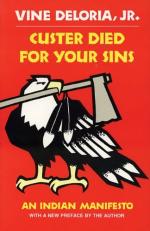
|
| Name: _________________________ | Period: ___________________ |
This test consists of 15 multiple choice questions and 5 short answer questions.
Multiple Choice Questions
1. What did the office of the Bureau of Indian Affairs in Albuquerque, New Mexico do to the Tigua of El Paso?
(a) They never visited, but sent money.
(b) They visited twice a year.
(c) They simply forgot about the tribe.
(d) They called them twice a year.
2. What has been the basis on which racial relations have been defined ever since the first settlers got off the boat?
(a) Money.
(b) Land.
(c) Hunting rights.
(d) Water rights.
3. What does the Native American Church use in its sacramental worship life?
(a) Communion.
(b) Prayer shawls.
(c) Dance.
(d) The peyote button.
4. What did the Indians see on TV that turned them off to the Civil Rights Movement?
(a) The March on Washington.
(b) Martin Luther King.
(c) Malcom X.
(d) Looting.
5. What did Indians joke about when asked what the country was called before "America?"
(a) "Indian."
(b) "Ours."
(c) "Land of the Brave."
(d) "Freedom."
6. Once a church was assigned to a reservation, what happened to the other churches?
(a) They were prohibited from entering a reservation.
(b) Other churches could invite Indians to worship on their reservation.
(c) They could also build a church on the same reservation.
(d) Other churches could talk to members of the reservation to try to gain access.
7. What does the author believe the Indians should have a right to, just like water districts, cities, and towns?
(a) Citizenship.
(b) Sovereignty.
(c) Voting rights.
(d) Social services.
8. According to the author, where should the Bureau of Indian Affairs be transferred?
(a) To the War Department.
(b) To the Foreign Service Department.
(c) To the Commerce Department.
(d) To the Interior Department.
9. What were the record years for the Christian church on the reservations?
(a) 1870 to 1930.
(b) 1855 to 1863.
(c) 1863 to 1910.
(d) 1850 to 1900.
10. What did the Supreme Court do in June of 1968?
(a) Interpreted an ancient statute in favor of blacks in the matter of purchasing a house.
(b) It drained a dam and gave Indians back land on the east coast.
(c) It ruled in favor of water rights for African Americans.
(d) It ruled in favor of urban development for Indians.
11. What did Senator Clinton Anderson announce in 1968?
(a) That the federal government needed to spend more money on the Indian.
(b) That the federal government was spending nearly half a billion dollars a year on Indian people and therefore he did not think they were so neglected.
(c) That the federal government needed to close the reservations.
(d) That the federal government should support only those Indians living in urban areas.
12. In 1967, where was the conference on Manpower held?
(a) Seattle.
(b) Kansas City.
(c) Chicago.
(d) New York.
13. What is the best service offered by the Bureau of Indian Affairs area offices?
(a) Helping with construction projects.
(b) Communication with Washington.
(c) Keeping records.
(d) Posting job openings.
14. Who are the Five Civilized Tribes?
(a) Seneca, Choctaw, Creek, Zuni and Cherokee.
(b) Cherokee, Choctaw, Creek, Seminole and Chickasaw.
(c) Cherokee, Choctaw, Creek, Seminole and Zuni.
(d) Cherokee, Apache, Zuni, Seminole and Chickasaw.
15. When Indians looked at pictures of the Disciples, what were they surprised to find?
(a) Their white faces.
(b) Their short hair.
(c) Their brown faces.
(d) Their shoulder-length hair.
Short Answer Questions
1. What was one good, tangible result of Indian participation in the Poor People's Campaign?
2. What basic principle of man's history, according to the author, did colonists violate?
3. What did Martin Luther King organize in the spring of 1968?
4. How many area offices does the Bureau of Indian Affairs have throughout the country?
5. What is the most popular and enduring subject of Indian humor?
|
This section contains 636 words (approx. 3 pages at 300 words per page) |

|




